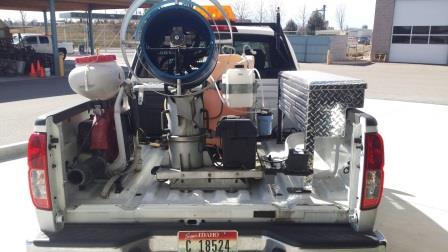The Ada County Mosquito Abatement District (ACMAD) is tasked with managing mosquito populations that pose a threat to public health and welfare. The most common mosquito-borne disease in the continental United States is West Nile Virus (WNV), which can be spread to people by the bite of an infected mosquito during the mosquito season (from summer through fall).
WNV was first detected in Ada County in 2005, and in 2006, Idaho led the nation with nearly 1,000 reported cases of WNV. Idaho State Law allows for abatement districts to take all necessary and proper steps for the control of mosquitos and other vermin of public health and welfare in the district. The abatement district grew into incorporate 406 square miles, with the majority of the district covering major residential and urban areas. ACMAD follows an Integrated Mosquito Management (IMM) program which is designed to reduce impacts from mosquito-borne disease with minimal adverse effects on people, wildlife, domestic animals, and the environment. An IMM program includes education, cultural, physical and mechanical controls, prevention, biological control, and chemical control.
As of November 30, 2018, the Center for Disease Control (CDC) website shows that there were 16 reported human cases of WNV in Idaho, with 2 cases in Ada County.

 There are about 3,000 species of mosquitos, worldwide. Roughly 175 species reside in the United States, and more than 50 can be found in Idaho.
There are about 3,000 species of mosquitos, worldwide. Roughly 175 species reside in the United States, and more than 50 can be found in Idaho.- Not all mosquito species are considered West Nile vectors. In Ada County, there are 6 species identified as WNV vectors, only two of which are considered primary vectors (species that share habitat with a West Nile host and feed on humans).
- Mosquitos are cold-blooded. They prefer temperatures above 80 degrees F and will hibernate below 50 degrees F.
- Only female mosquitos bite, and they can drink up to three times their weight in blood.
- Females can lay up to 300 eggs at one time and can lay eggs every 3 days.
- Mosquitoes have four distinct developmental stages: egg, larva, pupa and adult. On average, it takes about 5 to 7 days for a mosquito to develop from egg to adult. All mosquito species require aquatic habitats for development during the second and third stages.
The Ada County Mosquito Abatement District is focused on controlling the mosquito populations that pose a threat to public health and welfare, rather than controlling all mosquito populations. West Nile Virus is the most common disease spread by mosquitos and is the primary focus of Ada County.
West Nile Virus is a disease passed between birds and mosquitos in a cyclical fashion, which can be transmitted to mammals as dead-end hosts. On average, Eighty percent of those infected with WNV may not show symptoms, or show only mild symptoms. Some of the most commonly reported symptoms are fever, headaches, and fatigue, and 1% of those who are infected develop severe neurological symptoms (such as encephalitis), which may result in paralysis or death. WNV was first detected in Ada County in 2005, and in 2006, Idaho led the nation in human contraction of WNV, with nearly 1,000 reported cases resulting in 23 WNV-related deaths. Nearly every year since then, mosquitoes infected with WNV have been collected by ACMAD.
ACMAD follows an Integrated Mosquito Management (IMM) program, which is designed to benefit and to have minimal adverse effects on people, wildlife, domestic animals, and the environment. An IMM program includes education, cultural, physical and mechanical controls, prevention, biological control, and chemical control. We recognize that not all mosquito populations can be controlled using these methods, and there is no one way to use these practices due to variations in the mosquito population abundance, species diversity, time of year, development habitats and environmental conditions. ACMAD considers all controls carefully, using the aforementioned techniques as well as cost versus benefits analysis, efficacy, potential health effects and ecological impacts, including exposure risk potential for vector-borne diseases.
The Ada County Mosquito Abatement District controls vector mosquito populations utilizing a variety of services. Fill out an online Request for Service form, and one of our staff members will contact you.
- Services Include: Proactive Surveillance and Mapping Program, and Public Mosquito Tracker
- Physical Control Remediation (Habitat Removal)
- Larvicide Chemical Control Remediation
- Adulticide Chemical Control Remediation
- Education and Outreach
